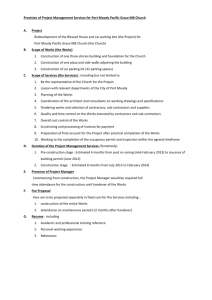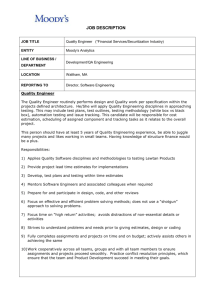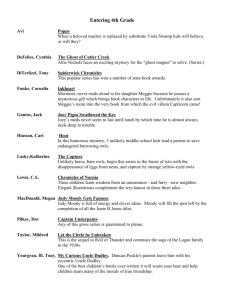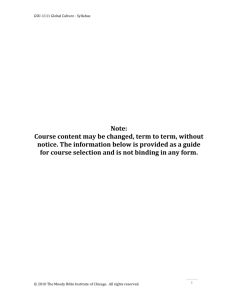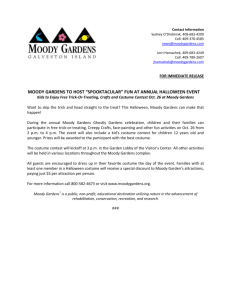view speaker presentation ( 1.56 MB)
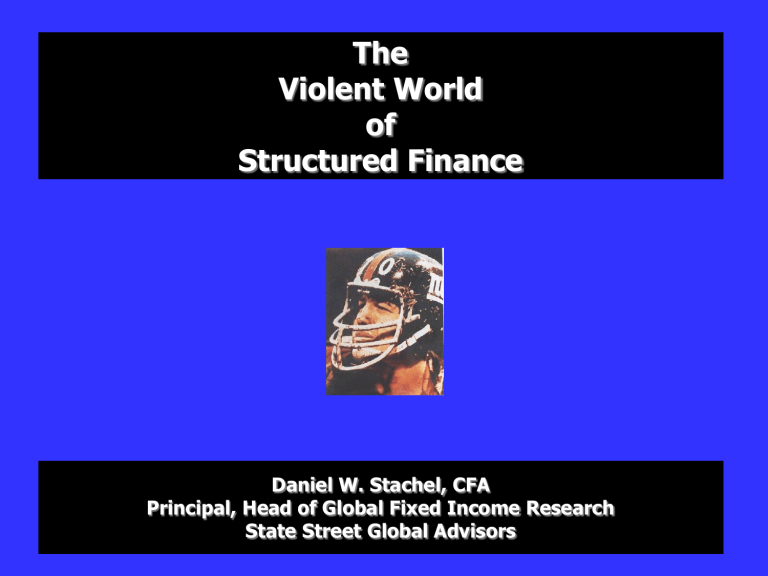
The
Violent World of
Structured Finance
Daniel W. Stachel, CFA
Principal, Head of Global Fixed Income Research
State Street Global Advisors
Who was that Masked Man ?
• That was Sam Huff.
• He was a Hall-of-Fame lineman for the New York Giants.
• He was the subject of NFL Film’s “The Violent World of Sam Huff”.
• He wore a microphone in his helmet, and had a dedicated camera.
2
My Analogy
• Playing in the NFL
– You can get hurt, badly.
– Some players are unscrupulous.
– Willingness is not the same as thing as capability.
– Knowing the rules is not enough.
• Investing in ABS
– You can get hurt, badly.
– Some players are unscrupulous.
– Willingness is not the same as thing as capability.
– Knowing the theory is not enough.
3
Fallen AAAs
4
Laws of Gravity I
• The Rating Agency Conflict of Interest:
– “Rating agencies… ‘wield immense power -- quasigovernmental power -- over companies, capital markets and our entire economy,’ as Connecticut Sen. Joseph Lieberman recently noted.”
– The rating agencies are “… an oligarchy, they exist in a comfortable environment… The regulations guarantee an artificial demand for their services. They have more incentive to cut costs than to do a good job.”
(Sender, “Heard on the Street: Moody's Swings, So Why Are Some Analysts Cautious?”, WSJ, 01/06/03)
5
Laws of Gravity II
• The Rating Agency Conflict of Interest:
– “Shares of Moody's Corp., the parent of bond-rating agency
Moody's Investors Service, have risen 53%, beating the overall market by 100 percentage points (sic), since the company began trading after being spun off from Dun & Bradstreet in September
2000.
”
(Sender, “Heard on the Street: Moody's Swings, So Why Are Some Analysts Cautious?”, WSJ, 01/06/03)
6
Laws of Gravity III
• AAA-rated ABS are manufactured, like widgets:
– Dealers and rating agencies are the manufacturers.
– Like widgets, revenues and profits are driven by volume.
– Like widgets, some AAA-rated ABS have defects.
• Unlike most widgets, AAA-rated ABS do not come with warranties:
– Multiple notch downgrades can take place at any time.
– No responsibility taken for fraud.
– “Burning bush” assumptions made but not disclosed.
7
Ulterior Motive
• Orthodox View
– “Financial statements attempt to portray the operating performance and financial health of a business firm during a period of time.”
• Revisionist View
– “The purpose of financial statements is to obtain cheap capital.”
(Stickney, Financial Reporting and Statement Analysis, 1996, page 1)
(Fridson, “Credit Analysis: A Battle Scarred Veteran’s View” 2002, page 89)
8
Volume Culture: Mirror Image
• Cash flow @ issuance
– Issuer
– Dealer
– Rating Agency
– Law Firm
– Trustee
• Cash flow @ maturity
– Investor
9
Volume Culture: “Seasoning”
10
Structured Finance Risks
• Collateral
• Documentation
• Enhancer
• Fraud
• Headline
• Legal
• Rating Agency
• Regulatory
• Servicer
• Trustee
11
Specific / Systematic / Wild Card
• Specific Risks
- Collateral
- Documentation
- Enhancer
- Fraud
- Headline
- Servicer
• Systematic Risks
- Legal
- Regulatory
- Trustee
- Volume Culture
• Wild Card Risk
- Rating Agency
12
Servicer Risk
• Heilig-Meyers 1998-1 and -2: The Basics
– Sen./mezz./sub; floating rate; 35% total enhancement for AAA.
– Ba1 rated “servicer”; parent company rating, not store rating.
– Furniture installment contracts generated by 562 (of 800) stores.
– Underwriting and servicing functions at 562 eligible stores/sellers.
– Voluntary Chapter 11 filing; petitioned to close 302 stores.
– 67% of obligors paid inside stores.
– Successor servicer must convince obligors to mail payments in.
13
Servicer / Rating Agency Risk
• Heilig-Meyers 1998-2
– “The execution of certain underwriting and servicing functions at the individual Heilig-Meyers stores poses unique credit and liquidity risks for the transaction, compared with most private label securitizations rated by Moody’s.” (my emphasis)
(Moody’s, “New Issue Report: Heilig-Meyers Master Trust, Series 1998-2”, 09/25/98, page 1)
14
Enhancer Risk
• Hollywood Funding #6: The Basics
– Secured zero coupon notes; 2.51 year average life.
– Secured by HF#6’s rights under film purchase agreements.
– Rights related to films produced by Flashpoint Ltd.
– Future flow revenues from 6 films, insured by “BJH” subsidiary.
– S&P was the only rating agency to rate this deal.
– Underwritten by CSFB, sold to a single ABCP conduit.
– None of the films met their revenue targets.
– “BJH” subsidiary refused to honor pecuniary loss indemnity policy.
– Conduit was forced to delever, and took unsustainable losses.
15
Enhancer Risk
• Hollywood Funding: Definition of Insured Peril
– “… the failure to generate a balance in the (relevant) escrow account as at the last day of the policy period equal to the sum insured, for any reason whatsoever.”
– “… includes, but is not limited to, the failure of the projects (as defined in the preamble to each policy) to generate a balance in the (relevant) collection account equal to, or in excess of, the sum insured for the failure of Flashpoint Ltd. to make any payment under the (relevant) purchase agreement for any reason whatsoever.”
(S&P, “Ratings Lowered on Hollywood Funding No. 5 and No. 6 Ltd.”, 04/22/03, page 1)
16
Enhancer Risk
• Hollywood Funding: Waiver of Remedies
– “Will not seek to or be entitled to avoid or rescind this policy or reject any claim hereunder or be entitled to seek any remedy or redress on the grounds of invalidity or unenforceability of any of its arrangements with Flashpoint Ltd. or any other person… or nondisclosure or misrepresentation by any person or any similar grounds. Lexington irrevocably agrees not to assert and waives any and all defences and rights of set-off and/or counterclaim… which it may have against the (trustee) or which might be available to deny payment of any amount due hereunder in accordance with the express terms hereof.”
(S&P, “Ratings Lowered on Hollywood Funding No. 5 and No. 6 Ltd.”, 04/22/03, page 1)
17
Enhancer / Rating Agency Risk
• Hollywood Funding: Blaming the Investor
–
“
After reviewing the insurance policies, Standard and Poor’s believed that the policies were absolute and unconditional, that there were no conditions or warranties that needed to be satisfied in order to draw on the policies… that Lexington had waived all of its payment on the policies, and that the policies met the standards of the capital market for credit enhancement of financial market instruments.” (my emphasis)
(S&P, “Ratings Lowered on Hollywood Funding No. 5 and No. 6 Ltd.”, 04/22/03, page 1)
18
Regulatory Risk
• NextCard: The Basics
– Internet credit card bank (NextBank) started operations in 1998.
– MC/Visa portfolio; FICO µ = 698, w/1.9% < 640 at offering.
– Senior/sub; floating rate 3 year and 5 year bullets; 9As.
– $1.8 billion; Rule 144a; CSFB led; five dealers in the selling group.
– OCC …
• Forced reclassification of certain losses as credit not fraud…
• … causing Tier 1 RBC to fall drastically (17.4% → 5.4%)…
• … leaving NextBank “significantly undercapitalized”…
• … leading to its closure on 02/07/02.
– Moody’s and S&P: “No immediate need to put on watch.”
19
Regulatory Risk
• NextCard: FDIC Actions
– “First, in February 2002, the FDIC stated that the early amortization event triggered by NextBank's receivership was not enforceable against them under FIRREA. (The transactions later began amortizing in July 2002, when excess spread triggers were hit.)
– Secondly, in early July 2002, the FDIC announced that they were unable to complete a sale of the trust's receivables and notified cardholders that they were shutting down all further credit advances on their accounts… many of the higher credit quality cardholders paid off their account balances, leaving behind a concentration of weaker obligors in the pool.”
(Moody’s, “2002 Review and 2003 Outlook U.S. Credit Card-Backed Securities” , 01/31/03, page 5)
20
Regulatory / Rating Agency Risk
• NextCard: Discovering America
– “… the FDIC's handling of the situation highlighted some credit card securitization risks that had previously been thought to be relatively remote… In light of the strategies employed by the FDIC in the NextCard liquidation, Moody's will give greater weight in future to the risk that credit card accounts could be shut down by bank regulators when the issuing bank is taken over.”
(Moody’s, “2002 Review and 2003 Outlook U.S. Credit Card-Backed Securities” 01/31/03, page 5)
21
Regulatory Risk: NextCard E. A.
50%
40%
30%
20%
10%
0%
Jan-02 Mar-02 May-02 Jul-02 Sep-02 Nov-02 Jan-03
Defaults Interest Servicing Yield
22
Regulatory Risk: NextCard E. A.
FDIC Shutdown: Feb-02
Early Amortization: Aug-02
$500
$400
$300
Class A
$200 Class B
$100
$0
Mar-01
Class C
Class D
Mar-02 Mar-03 Mar-04 Mar-05 Mar-06
23
Regulatory Risk
• First Consumers 1999-A: The Basics
– Spiegel issued bankcard ABS via First Consumers National Bank.
– First Consumers is an OCC-regulated banking subsidiary of Spiegel.
– Fixed rate, senior sub., 22.5% subordination.
– On 02/25/03, OCC forced Spiegel to…
• Stop providing bankcard credit to those w/FICOs < 680…
• … cease accepting deposits…
• … start funding a reserve account to pay current depositors…
• … eliminate open-to-buy on or before 04/30/03.
24
Regulatory Risk
• First Consumers:
– On 03/14/03, the OCC ordered First Consumers to…
• … increase the servicing fee from 2% to 7% …
• … as well as make the fee senior to all other trust payments…
– On 04/01/03, Moody’s revised First Consumer’s ABS ratings so that the “C”s were higher rated than the “B”s.
– While NextCard exemplifies regulatory risk after receivership, First
Consumers exemplifies regulatory risk before receivership.
25
Regulatory Risk: First Cons. E.A.
26
Collateral Risk
• NPF (National Century) 2000-3:
– Healthcare receivables securitizations (13 since 1998).
– Medicare, Medicaid, CHAMPUS and CHAMPVA.
– Blue Cross and Blue Shield plans, commercial insurers, HMOs.
– 4% subordination, overcollateralization, reserve.
– At LIBOR + 45, the cheapest deal in the discussion.
27
Collateral / Rating Agency Risk
• NPF (National Century) 2001-1: Reasons to be Cheerful
– “A ten-year performance history demonstrating the quality of the origination and servicing of the receivables.”
– “The legal and structural integrity of the securitization featuring
NPF XII (the Issuer) in contract with the healthcare provider for the sale of the receivables, thereby isolating the assets from the bankruptcy of the healthcare provider and both the program sponsor, National Century Financial Enterprises, Inc. and the master servicer, National Premier Financial Services, Inc. (National
Premier).”
(Moody’s, “New Issue Report: NPF XII” 2001-1, 06/01/01, page 1)
28
Trustee Risk
NPF XII (Bank One)
– “Over the last few months, NCFE directed the trustee in both trusts to remove funds from specified reserve accounts for purposes other than those specified in transaction documents… This includes the withdrawal of funds from the offset reserve and from the seller credit reserve… Bank One reports to Moody's that it made no investigation into the reasons for the reserve account withdrawals from NPF XII because they did not believe they were obligated to under the transaction documents.” (my emphasis)
(Moody’s, “Moody's Reports Latest Developments for NPF VI and NPF XII Investors”, 11/06/02, page 6)
29
Trustee Risk
• NPF VI (J.P. Morgan Chase)
– “According to our conversation with JP Morgan Chase, the trustee of NPF VI, recent similar withdrawals were made from the NPF VI transaction. The withdrawals from those reserve accounts were made during the course of prior months and were replenished with funds from liquidating receivables, such that those reserve funds met their required levels as of the monthly determination date.”
(my emphasis)
(Moody’s, “Moody's Reports Latest Developments for NPF VI and NPF XII Investors”, 11/06/02, page 6)
30
Trustee / Rating Agency Risk
• NPF: Mea Culpa
– “Moody's believes that it underestimated liquidity pressure NCFE faced, compounded by NCFE's inability to complete a new securitization after May of this year. Most importantly, we misjudged the measures NCFE would pursue to address this liquidity problem and the amount of oversight the trustees would provide regarding the use of funds in preparation for backup servicing.” (my emphasis)
(Moody’s, “Moody's Reports Latest Developments for NPF VI and NPF XII Investors”, 11/06/02, page 8)
31
Fraud Risk
• NPF
– “The daily cash collections for both trusts are considerably reduced from the levels reported in prior months.”
– “…the company failed to provide a satisfactory reconciliation of the cash flows reported in the monthly servicing reports and the levels of receivables reported in the trusts.”
– “…a crisis management firm… confirmed… that a significant portion of the receivables in both NPF VI and NPF XII consists of ineligible assets.”
(Moody’s, “Moody's Reports Latest Developments for NPF VI and NPF XII Investors”, 11/06/02, page 1)
32
Fraud / Rating Agency Risk
• NPF: What a Difference a Blow-up Makes
– …In earlier reports, Moody's noted that caution… is warranted, given the ease with which fraud is perpetrated at the finance company level and at the healthcare provider level. While Moody's ratings do not capture the probability that fraud will be committed, factors incident to the health-care industry that may create conditions where fraud could occur at either the finance company or healthcare provider level will continue to be evaluated.” (my emphasis)
(Moody’s, “Esoteric ABS: Will Investors Remain Interested in Exotics?” 01/29/03, page 3)
33
Documentation Risk
• “Bill Road Funding”
– “Borrowers Are Expected to Draw on Covered Commitments at a
Time of Credit Distress…”
• Structure pitched as traditional balance sheet CLO.
• Default risk pitched as equivalent to that of all entities with identical ratings.
• No discussion of adverse selection.
• “But its _______”.
34
Anti-Gravity Boots
• Beware securities with at least one, and especially more than one, of these characteristics:
– Non-investment grade servicer.
– Multiline insurance company as wrap provider.
– Marginal asset types in senior/subordinate structure.
– A structure rating agencies consider unique.
– Issued under Rule 144a.
35
Good Luck!
Caveat Emptor!
36
Acknowledgments
The preceding presentation could not have been completed without the aid and comfort of the following individuals:
Brian Clarkson
David Heike
Anthony Thompson
Nathan Trier
Moody’s Investor Service
Lehman Brothers
Deutsche Bank Securities
Moody’s Investor Service
37
Biography
Dan is a Principal of State Street Global Advisors and Unit Head-Research,
Global Fixed Income Investment Management. He joined the firm in 1994, and has held his current position since 1995. Dan and his staff of nine are responsible for the analysis, approval, and monitoring of approximately
$230 billion in cash, enhanced cash, securities lending collateral, and stable value investments made by SSgA for its clients, as well as firm wide counter party approvals. He has been working in the investment management field since 1987.
Dan was awarded a BA,
magna cum laude
from Brandeis University and an
MBA from Cornell University. He holds the Chartered Financial Analyst designation. Dan also serves as the Committee Head, Market Standard and Practices Committee of the American Securitization Forum, and is a member of the forum's Management Committee. Dan is also a member of
S&P’s Corporate and Government Ratings Investor Council.
38
